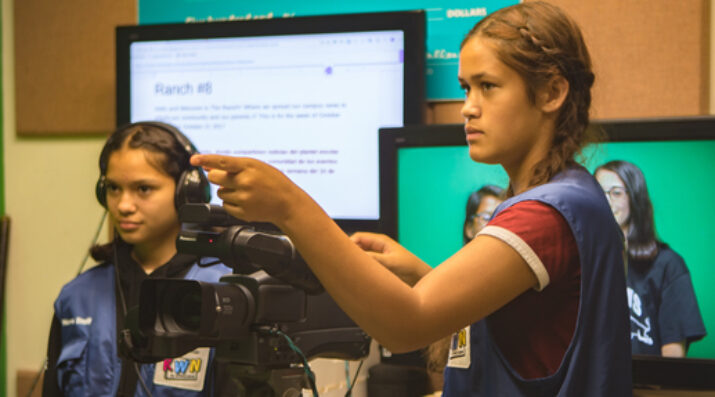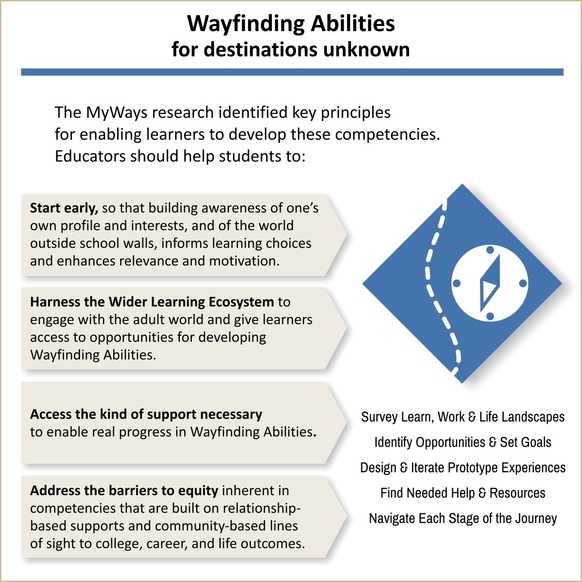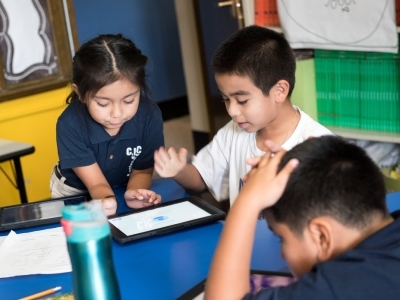Why Schools Need to Change
Wayfinding Abilities: Helping Students Chart a Course through Life
Topics

Today’s learners face an uncertain present and a rapidly changing future that demand far different skills and knowledge than were needed in the 20th century. We also know so much more about enabling deep, powerful learning than we ever did before. Our collective future depends on how well young people prepare for the challenges and opportunities of 21st-century life.
Practitioner’s Guide to Next Gen Learning
Many educators are actively supporting students to develop vital Wayfinding Abilities—the capacity to navigate college, career, and life opportunities.
“Wayfinding is the ancient art of figuring out where you are going when you don’t actually know your destination. For wayfinding, you need a compass and you need a direction. Not a map—a direction… Wayfinding your life is similar. Since there’s no one destination in life, you can’t put your goal into your GPS and get the turn-by-turn directions for how to get there.”
—Bill Burnett and Dave Evans, Designing Your Life
Throughout much of the 20th century, preparing students to graduate from high school was the ultimate goal for K-12 educators. A high school diploma was a ticket to a good job offering a living wage. More recently, in response to changes in our world, we’ve recognized the importance of postsecondary education as the key to a prosperous future. Accordingly, educators made college a priority for their students and retooled their programs to prepare students for that next step in their life’s journey.
However, the world continues to transform, and the pace of change is accelerating. New technologies and globalization are continually redefining the nature of work, and a bewildering array of postsecondary options have sprung up to compete for graduates’ money, energy, and time. For young people, navigating the work/learn landscape is becoming more complex and daunting. They can no longer count on a well-defined, linear school-college-career trajectory to lead them where they want to go. Wayfinding today is a lifelong endeavor.
This edition of Friday Focus: Practitioner’s Guide to Next Gen Learning is dedicated to Wayfinding Abilities, one of the four competency domains in NGLC’s MyWays Student Success Framework. Historically, these skills have not figured prominently in K-12 school models. However, more and more educators in the NGLC network are recognizing how vital they are for their students’ future success. In this issue I will explore:
- Why today’s learners need Wayfinding Abilities
- What these wayfinding competencies include
How educators can support students to achieve them
The Challenging Work/Learn Landscape
Students are coming of age in a time when the pathways to a successful life are numerous, challenging, and constantly shifting. According to the U.S. Bureau of Labor Statistics, the average worker currently holds ten different jobs before age forty, and this number is projected to grow. What’s more, many of the careers our students will pursue do not yet exist and will require technology that hasn’t yet been invented.
The nature of employment itself is also transforming, making it more difficult for students to navigate the transition from learning to working. More and more employers are replacing stable, full-time work with “on-demand” employment, in which highly skilled workers are hired for the duration of a specific project. In this “gig” economy, the premium is on experience. In a 2012 survey, for example, employers ranked work experience and internships significantly higher than college major or relevant coursework as hiring “look fors.” A college degree by itself no longer guarantees a successful launch into a career.
And though attending college is a worthy and increasingly common aspiration for young people, many who enroll never complete their degrees. As cited in Pathways to Prosperity: Meeting the Challenge of Preparing Young People for the 21st Century, the US now has the highest college dropout rate in the developing world. Nearly 70 percent of high school graduates go to college within two years of graduating, yet only about 4 in 10 students have obtained either an associate’s or bachelor’s degree by their mid-twenties. For students of color, college completion rates are dismal: only 30 percent of African-Americans and fewer than 20 percent of Latinos in their mid-20s have an associate’s degree or higher.
At the same time, young people have many more postsecondary education options available to them, each with its own advantages and disadvantages. Alongside the traditional four-year, full-time college experience are alternatives like attending community college and transferring, working full-time while studying, enrolling in a career-oriented, for-profit university, taking online coursework, earning certificates, pursuing gap year experiences, and participating in internships or apprenticeships.
High school students are now tasked with making high-stakes decisions about their futures, but the skills they need to make this transition—and all the others that will follow—are not part of traditional academics. Preparing for, finding, and securing the numerous jobs young people will work over a lifetime requires sophisticated wayfinding abilities and opportunities to develop them throughout their K-12 journeys.
Navigation Skills for Destinations Unknown
“Not only does the physical structure of high school isolate young people from the larger world, so does the academic focus. Young people are not exposed to the wide range of roles, fields and disciplines that make up our occupational and civic culture. Young people are too often left on their own, without the guidance, solid information, and preparatory experiences to underpin good decisions.”
—Robert Halpern, in It Takes a Whole Society: Opening up the Learning Landscape in the High School Years
College and career counseling has traditionally focused on helping students choose a defined path—a career, college major, or postsecondary school. Today, young people need to navigate multiple options and excel at making numerous transitions. Wayfinding is essentially a process—a navigation process—and the MyWays Wayfinding Abilities draw on knowledge, skills, habits, and behaviors that help students drive their own life decisions. In essence, Wayfinding Abilities prepare students to project-manage their lives.

Although the Wayfinding Abilities competencies and principles build on the practices of school-based college and career counseling, wayfinding skills are both broader and deeper. Moreover, they are not solely the responsibility of counselors or high schools. Educators in all subjects and at all grade levels can support students to develop these competencies:
Survey Learn, Work, & Life Landscapes. This Wayfinding Ability encompasses learning about both traditional and emerging postsecondary education, career, and other work/learn options that are aligned to students’ goals, strengths, and interests.
It also includes exposure to real-world experiences—the Wider Learning Ecosystem—so that students can know what career and life options are available in their locality and beyond. The Talent Cities initiative in Vista, CA, for example, is a partnership between schools and local industry sectors, with a mission to expand young people’s vision of themselves in the world of work, starting in middle school.
Some next gen learning models begin this work even earlier, providing students with tools and experiences to develop self-knowledge about their interests and unique talents. This Getting Smart story, for example, describes what career exploration can look like starting in kindergarten.
Identify Opportunities & Set Goals. Setting goals for student learning is not a new practice, but this competency involves approaching the practice in new ways. A one-size-fits-all, grade-level goal determined by an adult will not build students’ self-awareness or the capacity to set their own goals for learning, work, and life. To strengthen learners’ Wayfinding Abilities, goal-setting should be personalized and self-directed, reflecting students’ strengths, interests, and long-term goals, as well as the interim steps to reach them.
Recognizing the importance of this competency, many next gen learning models have made student goal-setting a pillar of their personalized learning approaches. This edition of the Friday Focus, for example, provides research, resources, and practices around student-led goal-setting at schools in the NGLC community.
Design & Iterate Prototype Experiences. This Wayfinding Ability translates goal-setting into action. To support young people as they transition from student to adult, educators in many next gen learning models design authentic projects and connect learners with real-world experiences like internships. Through powerful learning experiences connected to the world outside of school, students of all ages and backgrounds can gain access to the adult world, build social capital, and try out possible futures. They also gain a sense of empowerment as they discover the impact they can have on their community.
Because such prototype experiences enable students not only to develop academic skills and content but to learn about themselves and the world as well, they are central to many project- and problem-based learning models in the NGLC network. Especially as students move into their high school years, their learning can become increasingly authentic and grounded in their own potential futures, such as through partnerships with industry, higher education, and community organizations.
Find Needed Help & Resources. Asking for assistance and seeking out resources to achieve goals are essential skills for life. However, “resources” here also includes access to mentors, role models, and weak-tie contacts in students’ fields of interest. In other words, this competency requires students to cultivate a help-seeking mindset and to reach out to adults, something young people often find difficult to do on their own.
Moreover, opportunities to build social capital and create such networks of support are not distributed equitably. Therefore, educators engaged in equity by design create learning experiences that intentionally develop students’ social capital. Through forging relationships in real-world contexts, students can build a professional network to help them tap others’ insights, find opportunities, and make better education and career decisions.
Navigate Each Stage of the Journey. Perhaps if the path through adult life were linear and well-defined, this competency would not be so important. However, as we saw above, modern life is complex and constantly changing. Young people need flexibility and adaptability, as well as the skills and habits of making mid-course corrections based on new learning and experience.
To cultivate students’ ability to take risks, reframe, and change direction, forward-thinking educators in the NGLC community often turn to the tools and processes of design thinking and entrepreneurship, in which students achieve success by trying, failing, and iterating in calculated and reflective ways.
Taken together, the competencies of the MyWays Wayfinding Abilities domain strive to develop students’ capacity to chart their own courses—not as path-followers but as self-reliant navigators through life.
Resources
Opportunity, Work, and the Wayfinding Decade, Report 1 of the MyWays Student Success Series, examines changes in society and the labor market that have transformed students’ transition from high school to gainful employment into a challenging wayfinding decade.
Understand the Changing World is an online course for educators (free, login required), developed by NGLC and 2Revolutions. Its four learning modules and culminating task include readings, videos, and activities that support educators to answer the question, “Why do schools need to change?”
Wayfinding Abilities for Destinations Unknown, Report 10 of the MyWays Student Success Series, explores the competencies of the Wayfinding Abilities domain in greater depth, along with the key principles for learning design and links to exemplars and resources.
Pathways to Prosperity: Meeting the Challenge of Preparing Young People for the 21st Century, a Harvard Graduate School of Education publication, makes the case for the development of multiple pathways leading from high school to postsecondary education or career training.
Robert Halpern’s It Takes a Whole Society: Opening up the Learning Landscape in the High School Years presents a rationale, guidance, and numerous examples of ways to overcome the tendency to view academic and applied learning in “either-or” terms in order to create a richer fabric of learning opportunities for a diverse population of youth.




